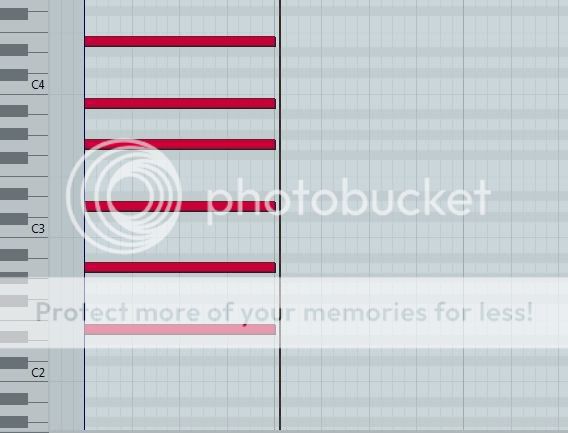They say a little knowledge is a dangerous thing. You again epitomise this saying to the letter.
The low E on the guitar is tuned to the E at the bottom of the bass clef - this is not the one immediately to the left of middle C, but the one an octave below it. If it were as you claim then middle C would be tuned to ca. 131Hz, rather than ca 263Hz. This note is E1 ca. 82Hz.
When writing for the guitar it is
written an octave above it's
sounding pitch. I.E. the lowest note is written as E2 but sounds as E1, so no error unless you are trying to play everything an octave higher.
Sorry, Bandcoach, I didn't have a question about the midi editor.
I was not commenting on the editor as such - I was commenting on the use of note numbers and octaves that do not correspond to the pitch of the guitar as they sound - these notes have been input for the written range not the sounding range. When playing on the piano a pianist will want to play notes from the sounding range not the written range.
My question was why you're MIDI NN's didn't match the ISO standard for MIDI NN's. But then I figured it out. No 'misinformation', just a little confusion because you were using a different standard. The notes on the midi editor are in Cubase and are the correct starting notes on a standard tuned guitar.
Please point me to the ISO standard for MIDI note numbers - afaik it does not exist. There is the MIDI Manufacturers Association Standard, which is the MIDI Standard that has been in use since 1982. It sounds like you are actually referring to DIN Octave numbers not MIDI note numbers, but even then, Cubase (in spite of being German in origin) does not use these Octave numbers, adhering instead to the MIDI standard.
As far as the strings go, you are agreed on the frequencies I've provided, correct? Because I think referring to them as the actual frequencies they are might clear up a little of the confusion.
As you can read above no disagreement about individual freqs for strings.
Like I said, I later realized you were referring to middle C as C3 and that they were referring to it as C4. I looked up a lot of graphs and they seem to vary on which system they use.
However, if you're referring to middle C as C3, I think you're list of notes for the guitar is an octave too low. With middle C being C3, the guitar would start on E2; not E1.
See above, this is impossible as the pitch of middle C would be dropped an octave - Middle C on the Guitar is the first fret on the B string, 5th fret on the G string, 10th fret on the D string, 15th fret on the A string and 20th fret on the Low E string, i.e. it is more than octave above the Low E rather than less than the single octave you are asserting.
To clarify for the OP, the lowest note on the guitar (standardly tuned) is first E to the left of middle C.
You clarify nothing here, only misinform with your incomplete grasp of notation for guitar.
To further clarify and put this to rest: Several Guitar chords on each of A, B, C, D, E, F and G. The guitar is shown at
notation octave, but played back at
sounding octave; the piano is at
notation and
sounding octave.
A
[mp3]http://www.bandcoach.org/fp/audio/GCFP-A.mp3[/mp3]
B
[mp3]http://www.bandcoach.org/fp/audio/GCFP-B.mp3[/mp3]
C
[mp3]http://www.bandcoach.org/fp/audio/GCFP-C.mp3[/mp3]
D
[mp3]http://www.bandcoach.org/fp/audio/GCFP-D.mp3[/mp3]
E
[mp3]http://www.bandcoach.org/fp/audio/GCFP-E.mp3[/mp3]
F
[mp3]http://www.bandcoach.org/fp/audio/GCFP-F.mp3[/mp3]
G
[mp3]http://www.bandcoach.org/fp/audio/GCFP-G.mp3[/mp3]
I leave the flat/sharp naming notes to you to sort out.













